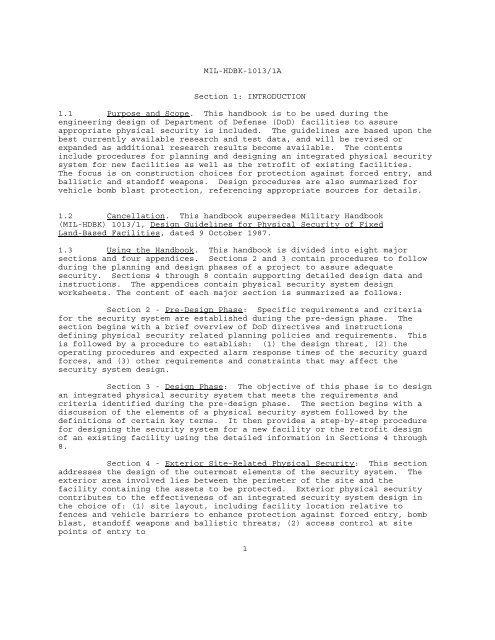MIL-HDBK-1013/1A Design Guidelines for Physical Security of ...
MIL-HDBK-1013/1A Design Guidelines for Physical Security of ...
MIL-HDBK-1013/1A Design Guidelines for Physical Security of ...
You also want an ePaper? Increase the reach of your titles
YUMPU automatically turns print PDFs into web optimized ePapers that Google loves.
<strong>MIL</strong>-<strong>HDBK</strong>-<strong>1013</strong>/<strong>1A</strong><br />
Section 1: INTRODUCTION<br />
1.1 Purpose and Scope. This handbook is to be used during the<br />
engineering design <strong>of</strong> Department <strong>of</strong> Defense (DoD) facilities to assure<br />
appropriate physical security is included. The guidelines are based upon the<br />
best currently available research and test data, and will be revised or<br />
expanded as additional research results become available. The contents<br />
include procedures <strong>for</strong> planning and designing an integrated physical security<br />
system <strong>for</strong> new facilities as well as the retr<strong>of</strong>it <strong>of</strong> existing facilities.<br />
The focus is on construction choices <strong>for</strong> protection against <strong>for</strong>ced entry, and<br />
ballistic and stand<strong>of</strong>f weapons. <strong>Design</strong> procedures are also summarized <strong>for</strong><br />
vehicle bomb blast protection, referencing appropriate sources <strong>for</strong> details.<br />
1.2 Cancellation. This handbook supersedes Military Handbook<br />
(<strong>MIL</strong>-<strong>HDBK</strong>) <strong>1013</strong>/1, <strong>Design</strong> <strong>Guidelines</strong> <strong>for</strong> <strong>Physical</strong> <strong>Security</strong> <strong>of</strong> Fixed<br />
Land-Based Facilities, dated 9 October 1987.<br />
1.3 Using the Handbook. This handbook is divided into eight major<br />
sections and four appendices. Sections 2 and 3 contain procedures to follow<br />
during the planning and design phases <strong>of</strong> a project to assure adequate<br />
security. Sections 4 through 8 contain supporting detailed design data and<br />
instructions. The appendices contain physical security system design<br />
worksheets. The content <strong>of</strong> each major section is summarized as follows:<br />
Section 2 - Pre-<strong>Design</strong> Phase: Specific requirements and criteria<br />
<strong>for</strong> the security system are established during the pre-design phase. The<br />
section begins with a brief overview <strong>of</strong> DoD directives and instructions<br />
defining physical security related planning policies and requirements. This<br />
is followed by a procedure to establish: (1) the design threat, (2) the<br />
operating procedures and expected alarm response times <strong>of</strong> the security guard<br />
<strong>for</strong>ces, and (3) other requirements and constraints that may affect the<br />
security system design.<br />
Section 3 - <strong>Design</strong> Phase: The objective <strong>of</strong> this phase is to design<br />
an integrated physical security system that meets the requirements and<br />
criteria identified during the pre-design phase. The section begins with a<br />
discussion <strong>of</strong> the elements <strong>of</strong> a physical security system followed by the<br />
definitions <strong>of</strong> certain key terms. It then provides a step-by-step procedure<br />
<strong>for</strong> designing the security system <strong>for</strong> a new facility or the retr<strong>of</strong>it design<br />
<strong>of</strong> an existing facility using the detailed in<strong>for</strong>mation in Sections 4 through<br />
8.<br />
Section 4 - Exterior Site-Related <strong>Physical</strong> <strong>Security</strong>: This section<br />
addresses the design <strong>of</strong> the outermost elements <strong>of</strong> the security system. The<br />
exterior area involved lies between the perimeter <strong>of</strong> the site and the<br />
facility containing the assets to be protected. Exterior physical security<br />
contributes to the effectiveness <strong>of</strong> an integrated security system design in<br />
the choice <strong>of</strong>: (1) site layout, including facility location relative to<br />
fences and vehicle barriers to enhance protection against <strong>for</strong>ced entry, bomb<br />
blast, stand<strong>of</strong>f weapons and ballistic threats; (2) access control at site<br />
points <strong>of</strong> entry to<br />
1

















